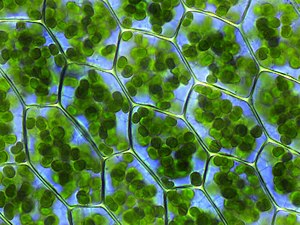கணிகங்கள்
கணிகம் (plastid) (Greek: πλαστός; plastós: formed, molded – பன்மை கணிகங்கள்) என்பது படலஞ்சூழ் தாவர உறுப்பாகும்.[1] இவை தாவர, பாசி, பிற முழுக்கருவன் உயிரிகளின் உயிர்க்கலங்களில் அமைந்துள்ளன. இவை கலத்திடைவாழ் அக இணைவாழ்வி நீலப்பசும் குச்சுயிரிகளாகும். எடுத்துக்காட்டுகளாக, ஒளிச்சேர்க்கை செய்யும் பசுங்கணிகங்கள், நிறந் தொகுத்துத் தேக்கும் நிறக்கணிகங்கள், சற்றே வேறுபடும் நிறமற்ற கணிகங்கள் ஆகியன அமைகின்றன.
| கணிகங்கள் | |
|---|---|
| உயிரியல் வகைப்பாடு | |
| Unrecognized taxon (fix): | கணிகங்கள் |

நிலத் தாவரங்களின் கவைப்பிரிவான தொல்கணிக உயிரிகளான செம்பாசிகளிலும் பசும்பாசிகளிலும் தான் முதன்முதலில் அக இணைவாழ்வு நிகழ்வு1.5 பில்லியன் ஆண்டுகளுக்கு முன்பு தோற்றம் கண்டது. இதில் குளோயெவோமார்கரித்தா பேரினத்தைச் சேர்ந்த இணைவாழ்வு நீலப்பசும் குச்சுயிரிகளும் அமைந்தன.[2][3] பிற, முதன்மையான அக இணைவாழ்வு நிகழ்வு, ஒளிச்சேர்க்கை செய்யும் பவுலினெல்லா அமீபியாயிடுகளில் 90 முதல் 140 மில்லியன் ஆண்டுகளுக்கு முன்பு தோன்றியது.இந்தக் கணிகங்கள் புரோகுளோரோகாக்கசு, சைனெக்கோகாக்கசு பேரினங்களின் ஒளிச்சேர்க்கைக் கவைப்பிரிவுக்கு உரியனவாகும்.[4][5]

மேற்கோள்கள்
தொகு- ↑ Sato N (2006). "Origin and Evolution of Plastids: Genomic View on the Unification and Diversity of Plastids". In Wise RR, Hoober JK (eds.). The Structure and Function of Plastids. Advances in Photosynthesis and Respiration. Vol. 23. Springer Netherlands. pp. 75–102. எண்ணிம ஆவணச் சுட்டி:10.1007/978-1-4020-4061-0_4. பன்னாட்டுத் தரப்புத்தக எண் 978-1-4020-4060-3.
- ↑ "An Expanded Ribosomal Phylogeny of Cyanobacteria Supports a Deep Placement of Plastids" (in en). Frontiers in Microbiology 10: 1612. 2019. doi:10.3389/fmicb.2019.01612. பப்மெட்:31354692.
- ↑ Vries, Jan de; Gould, Sven B. (2018-01-15). "The monoplastidic bottleneck in algae and plant evolution" (in en). Journal of Cell Science 131 (2): jcs203414. doi:10.1242/jcs.203414. பன்னாட்டுத் தர தொடர் எண்:0021-9533. பப்மெட்:28893840. https://jcs.biologists.org/content/131/2/jcs203414.
- ↑ Marin, Birger; Nowack, Eva CM; Glöckner, Gernot; Melkonian, Michael (2007-06-05). "The ancestor of the Paulinella chromatophore obtained a carboxysomal operon by horizontal gene transfer from a Nitrococcus-like γ-proteobacterium". BMC Evolutionary Biology 7: 85. doi:10.1186/1471-2148-7-85. பப்மெட்:17550603.
- ↑ Ochoa de Alda, Jesús A. G.; Esteban, Rocío; Diago, María Luz; Houmard, Jean (2014-01-29). "The plastid ancestor originated among one of the major cyanobacterial lineages" (in en). Nature Communications 5 (1): 4937. doi:10.1038/ncomms5937. பன்னாட்டுத் தர தொடர் எண்:2041-1723. பப்மெட்:25222494. Bibcode: 2014NatCo...5.4937O.
மேலும் படிக்க
தொகு- Hanson MR, Köhler RH. "A Novel View of Chloroplast Structure". Plant Physiology Online. Archived from the original on 2005-06-14.
- "Continuous expression in tobacco leaves of a Brassica napus PEND homologue blocks differentiation of plastids and development of palisade cells". The Plant Journal 44 (1): 1–15. October 2005. doi:10.1111/j.1365-313X.2005.02482.x. பப்மெட்:16167891.
- "The inheritance of genes in mitochondria and chloroplasts: laws, mechanisms, and models". Annual Review of Genetics 35: 125–48. 2001. doi:10.1146/annurev.genet.35.102401.090231. பப்மெட்:11700280. http://www.hos.ufl.edu/ctdcweb/Birky01.pdf. பார்த்த நாள்: 2009-03-01.
- "The origins of plastids". Nature Education 3 (9): 84. 2010. http://www.nature.com/scitable/topicpage/the-origin-of-plastids-14125758.
- Bhattacharya D, ed. (1997). Origins of Algae and their Plastids. New York: Springer-Verlag/Wein. பன்னாட்டுத் தரப்புத்தக எண் 978-3-211-83036-9.
- "Plastid evolution". Annual Review of Plant Biology 59: 491–517. 2008. doi:10.1146/annurev.arplant.59.032607.092915. பப்மெட்:18315522. https://semanticscholar.org/paper/9e1e451bad28d9088b90cd55777d74358977f048.
- "The endosymbiotic origin, diversification and fate of plastids". Philosophical Transactions of the Royal Society of London. Series B, Biological Sciences 365 (1541): 729–48. March 2010. doi:10.1098/rstb.2009.0103. பப்மெட்:20124341.
வெளி இணைப்புகள்
தொகு- Transplastomic plants for biocontainment (biological confinement of transgenes) — Co-extra research project on coexistence and traceability of GM and non-GM supply chains
- Tree of Life Eukaryotes